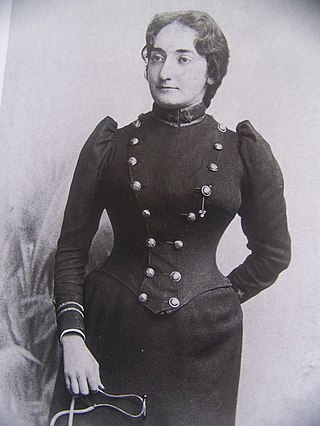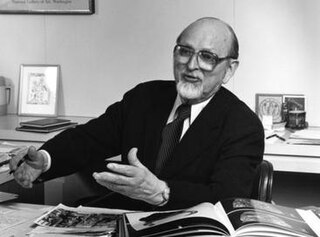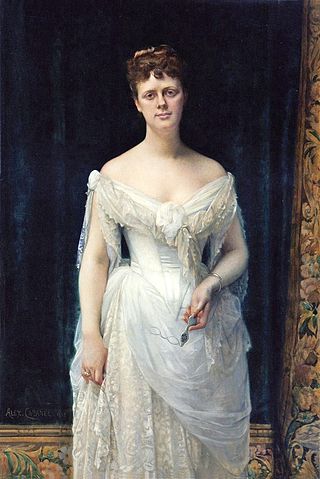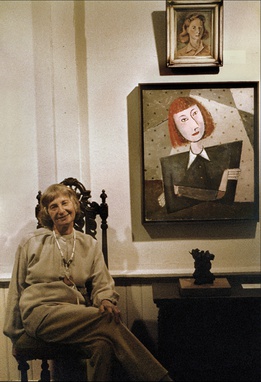Related Research Articles

The Baltimore Museum of Art (BMA) in Baltimore, Maryland, is an art museum that was founded in 1914. The BMA's collection of 95,000 objects encompasses more than 1,000 works by Henri Matisse anchored by the Cone Collection of modern art, as well as one of the nation's finest holdings of prints, drawings, and photographs. The galleries currently showcase collections of art from Africa; works by established and emerging contemporary artists; European and American paintings, sculpture, and decorative arts; ancient Antioch mosaics; art from Asia, and textiles from around the world.
Florence Elizabeth Riefle Bahr was an American artist and activist. She made portraits of children and adults, including studies of nature as she found it. Instead of using a camera, more than 300 pen and ink sketchbooks catalog insights into her life, including her civil and human rights activism of the 1960s and 1970s. One of the many important captured events included the Washington D.C. event where Martin Luther King Jr. first gave his I Have a Dream speech. Her painting Homage to Martin Luther King hangs in the (NAACP) National Association for the Advancement of Colored People's headquarters. She created illustrations for children's books and painted a mural in the Works Progress Administration (WPA) for the Johns Hopkins Hospital's Harriet Lane Home for Children. Her works have been exhibited in solo and group exhibitions since the 1930s. In 1999, she was posthumously awarded to the State of Maryland's Women's Hall of Fame, as the first woman artist they recognized.

Claribel Cone (1864–1929) and Etta Cone (1870–1949), collectively known as the Cone sisters, were active as American art collectors, world travelers, and socialites during the first part of the 20th century. Claribel trained as a physician and Etta as a pianist. Their social circle included Henri Matisse, Pablo Picasso and Gertrude Stein. They gathered one of the best known private collections of modern art in the United States at their Baltimore apartments, and the collection now makes up a wing of the Baltimore Museum of Art. Their collection was estimated to be worth almost a billion US dollars in 2002.

Rebecca Alban Hoffberger is the Founder, Primary Curator, and Director Emeritus of the American Visionary Art Museum, America's official national museum for visionary art, located in Baltimore, Maryland.

Joan Erbe Udel was a Baltimore painter and sculptor. She was best known for using bright colors and was called "The Grand Duchess of Baltimore Painters" by Ned Oldham as quoted by Rebecca Hoffberger in Baltimore Magazine. She received her training at the Maryland Institute College of Art, where she was a student of Leonard Bahr and Louis Bouché.

Charles Percy Parkhurst was an American museum curator best known for his work on the Roberts Commission, tracking down art looted during World War II.

Carla Diane Hayden is an American librarian who is serving as the 14th librarian of Congress. Since the creation of the office of the librarian of Congress in 1802, Hayden is both the first African American and the first woman to hold this post. Appointed in 2016, she is the first professional librarian to hold the post since 1974.
Saidie Adler May (1879–1951) was an American collector of Surrealist and early Abstract Expressionist art. She was a major benefactor to the Baltimore Museum of Art, the San Diego Museum of Art and the Museum of Modern Art in New York.
Thomas Cromwell Corner (1865–1938) was a portrait artist from Baltimore, Maryland, USA and founding member of the Baltimore Museum of Art.
Dena Katzenberg was the longtime textile curator at the Baltimore Museum of Art and is noted for her scholarship on Baltimore album quilts.

Mary Frick Garrett Jacobs was a Baltimore socialite, philanthropist, and art collector. She is best known for her collection at the Baltimore Museum of Art.

Joyce J. Scott is an African-American artist, sculptor, quilter, performance artist, installation artist, print-maker, lecturer and educator. Named a MacArthur Fellow in 2016, and a Smithsonian Visionary Artist in 2019, Scott is best known for her figurative sculptures and jewelry using free form, off-loom beadweaving techniques, similar to a peyote stitch. Each piece is often constructed using thousands of glass seed beads or pony beads, and sometimes other found objects or materials such as glass, quilting and leather. In 2018, she was hailed for working in new medium — a mixture of soil, clay, straw, and cement — for a sculpture meant to disintegrate and return to the earth. Scott is influenced by a variety of diverse cultures, including Native American and African traditions, Mexican, Czech, and Russian beadwork, illustration and comic books, and pop culture.
Marjorie Rowland Clarke (1908–1997) was an American artist and sculptor who won the federal commission to complete the post office mural for Wewoka, Oklahoma, as part of the Section of Painting and Sculpture′s projects, later called the Section of Fine Arts, of the Treasury Department. In addition to her mural, the University of Maryland medical buildings exhibit her sculptures.

Gertrude Carman Bussey was an American academic philosopher and activist for women's rights, civil liberties, and peace.

Selma Levy Oppenheimer was an artist from Baltimore.
Chrystelle Lee Trump Bond was an American dancer, choreographer, dance historian, and author. Bond was the founding chair of the dance department at Goucher College. She was the co-founder and director of Chorégraphie Antique, the dance history ensemble at Goucher. Bond was a dance critic for The Baltimore Sun.

Amalie Rothschild (1916–2001) was an American artist who lived and worked within the art community of Baltimore, Maryland. An accomplished painter and sculptor, she was also an art teacher, philanthropist, patron, and cultural advocate. Over the course of a long career, she made oil and acrylic paintings as well as drawings, watercolors, and other paper works. She also sculpted using found objects, Plexiglas, metals, and particleboard. Originally working in a realist style, she became well known for geometric abstractions based on figurative subjects. In 1993 a critic described this approach as "[walking] a tightrope between the abstract and the representational with a suggestion of three-dimensional depth." Rothschild was by choice a regional artist. Although she occasionally exhibited elsewhere, she did not actively promote her career outside a mid-Atlantic region centered on Baltimore. Thus, in 1997 a critic wrote, "Amalie Rothschild is a fixture and ornament of the Baltimore art world." At the time of her death a critic gave this career summary: "She was one of the leading artists of her time in this area. Her work is thoroughly modern and related to geometric abstraction, but without losing the figure. It has emotional reserve, often contains a hint of humor and at times recalls the childlike sagacity of the great Paul Klee."
Elinor B. Cahn was an American photographer. Cahn, who became a photographer later in life, was known for her photographs of street and neighborhood life in East Baltimore, Maryland.
Julia Marciari-Alexander is an American art historian and curator who is director of the Walters Art Museum.

Florence Hochschild Austrian was an American artist and preservationist from Baltimore, Maryland.